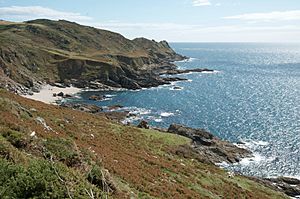Salcombe Cannon Wreck facts for kids
The Salcombe Cannon wrecksite is a special underwater place near the Erme Estuary in England. It's where an old ship sank long ago. This site is close to two other important shipwrecks.
In 1992, a group of underwater explorers called the South West Maritime Archaeological Group (SWMAG) first looked at the site. They only saw a cannon there, so they called it "A cannon site with nothing else visible."
Contents
Discovering Hidden Treasures
In 1994, the seabed changed, and more amazing things started to appear. The SWMAG group found other old items, including gold! They began to carefully record everything they found.
They discovered coins and jewellery that were made between 1510 and 1636. These treasures were later bought by the famous British Museum in 1998.
For a while, information about the site was kept secret. Only a few people knew, like the "Receiver of Wreck" (who handles shipwreck finds) and a special diving team. But in 1997, the site was officially protected under the Protection of Wrecks Act. That's when the news became public! Today, this wreck is a "Protected Wreck" and is looked after by Historic England.
The Mystery Ship
We don't know the name of the ship that sank here. But experts believe it went down sometime between 1630 and 1640. This wreck has given us the biggest collection of Moroccan gold ever found in Europe!
How They Explored the Wreck
To learn more about the site, divers and scientists used different methods:
- Traditional survey methods: This means carefully measuring and mapping the area.
- Magnetometer: A tool that finds metal objects hidden under the sand.
- Multi-beam sonar: This uses sound waves to create a 3D map of the seabed.
- Photo-mosaic: Many photos are stitched together to make one big, detailed picture of the wreck.
Even Older Discoveries
In 2004, divers at the Salcombe Cannon site made an even more surprising discovery. They found items from the Bronze Age! This was a time period thousands of years ago.
These finds included swords, axes, tools, and ornaments. They date back to around the 13th century BC. It's possible these items came from the same source as similar finds at the nearby Moor Sands site.
This area with the Bronze Age items is sometimes called the Salcombe B site. It's not a separate protected area because it's already inside the protected zone of the Salcombe Cannon site.


